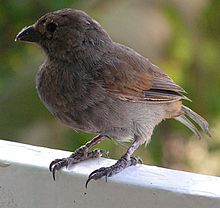| Barbados bullfinch | |
|---|---|

| |
| Conservation status | |
 Least Concern (IUCN 3.1) | |
| Scientific classification | |
| Domain: | Eukaryota |
| Kingdom: | Animalia |
| Phylum: | Chordata |
| Class: | Aves |
| Order: | Passeriformes |
| Family: | Thraupidae |
| Genus: | Loxigilla |
| Species: | L. barbadensis |
| Binomial name | |
| Loxigilla barbadensis Cory, 1886 | |

| |
The Barbados bullfinch (Loxigilla barbadensis) is a seedeater bird that is found only on the Caribbean island-nation of Barbados, where it is the only endemic bird species.
Taxonomy
The Barbados bullfinch was previously considered a subspecies of the Lesser Antillean bullfinch (Loxigilla noctis), which is found on neighboring islands. Despite the misleading nature of its name, the Barbados bullfinch is not a bullfinch at all but a seedeater. The bird is known locally as a Sparrow or Sparky.
Description
The Barbados bullfinch is a small bird, 14–15 cm (5.5–6 in). The upperparts are a dark olive-grey, the wings are mostly brown, underparts are greyish, while the under tail-coverts are tawny. The species is not sexually dimorphic, with females and males having similar plumage. The birds' calls include simple twittering, an occasional harsh petulant note, and a sharp trill .
Distribution and habitat
The Barbados bullfinch is found only on the island of Barbados. The birds' habitat includes shrubbery and forest undergrowth; the species has adapted well to humans, often being found in close proximity to areas of human habitation, such as gardens.
Reproduction
Barbados bullfinches construct a globular nest, with a side entrance, in a tree or shrub. The species lays two to three spotted eggs.
Behavior
Barbados bullfinches are extremely innovative and tame birds. Barbados bullfinches living in urban environments were found to have better problem-solving skills and a better immunocompetence than the ones living in rural areas of Barbados. As for their temperament, urban Barbados bullfinches were found to be bolder but more neophobic than their rural counterparts.
Gallery
References
- BirdLife International (2016). "Loxigilla barbadensis". IUCN Red List of Threatened Species. 2016: e.T22734682A95094761. doi:10.2305/IUCN.UK.2016-3.RLTS.T22734682A95094761.en. Retrieved 12 November 2021.
- Buckley, P.A.; Buckley, F.G. (2004). "Rapid speciation by a Lesser Antillean endemic, Barbados Bullfinch Loxigilla barbadensis". Bulletin of the British Ornithologists' Club. 125: 108–123.
- Banks, R.C.; Cicero, C.; Dunn, J.L.; Kratter, A.W.; Rasmussen, P.C.; Remsen, J.V.; Rising, J.D.; Stotz, D.F. (2006). "Forty-Seventh Supplement to the American Ornithologists' Union Check-List of North American Birds". The Auk. 123 (3): 926–936. doi:10.1093/auk/123.3.926.
- Reader, Simon M.; Nover, Daniel; Lefebvre, Louis (2002-01-01). "Locale-Specific Sugar Packet Opening by Lesser Antillean Bullfinches in Barbados (Individuos de Loxigilla noctis abren paquetes de azúcar en una área localizada de Barbados)". Journal of Field Ornithology. 73 (1): 82–85. doi:10.1648/0273-8570-73.1.82. hdl:1874/12407. JSTOR 4131071. S2CID 14665780.
- Ducatez, S.; Audet, J. N.; Lefebvre, L. (2013-02-14). "Independent appearance of an innovative feeding behaviour in Antillean bullfinches". Animal Cognition. 16 (3): 525–529. doi:10.1007/s10071-013-0612-4. ISSN 1435-9448. PMID 23408337. S2CID 14815365.
- Lefebvre, Louis; Ducatez, Simon; Audet, Jean-Nicolas (2016-03-19). "Feeding innovations in a nested phylogeny of Neotropical passerines". Phil. Trans. R. Soc. B. 371 (1690): 20150188. doi:10.1098/rstb.2015.0188. ISSN 0962-8436. PMC 4780530. PMID 26926278.
- ^ Audet, Jean-Nicolas; Ducatez, Simon; Lefebvre, Louis (2016-03-01). "The town bird and the country bird: problem solving and immunocompetence vary with urbanization". Behavioral Ecology. 27 (2): 637–644. doi:10.1093/beheco/arv201. ISSN 1045-2249.
- "Barbados Bullfinch (Loxigilla barbadensis) - BirdLife species factsheet". birdlife.org. 2012. Retrieved 26 January 2012.
External links
![]() Media related to Loxigilla barbadensis at Wikimedia Commons
Media related to Loxigilla barbadensis at Wikimedia Commons
| Taxon identifiers | |
|---|---|
| Loxigilla barbadensis | |


